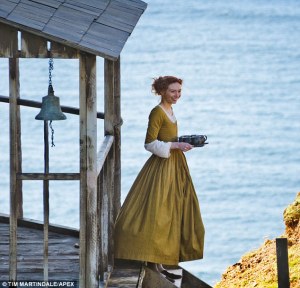There’s an interesting article in The Times today (‘When TV is your style guru’, Harriet Walker) about the way in which, these days, we get our fashion information direct from film and TV – the article cites programmes such as Game of Thrones and Mad Men as being particularly influential.
Now, I don’t think this phenomenon is new. If I look back to my own teenage obsession with fashion, it was influenced far more by film than by magazines (which I couldn’t afford) or newspapers (which were bought, rarely, by my parents and not available for me to read).
I always had an interest in clothes, fed in part by my Auntie, only six years older than me, who passed down some very trendy 1960s clothing. I especially remember the hot pink tartan kilt and matching skinny rib jumper, and the lurid orange nylon bell-bottom jumpsuit that produced marvellous amounts of static, creating a lovely light show under the bedclothes, or in any darkened room.
But the experience that suddenly made me aware that fashion was created, and then fed to the public, as opposed to being a response to public taste, was going to the cinema to watch the John Wayne film Hellraisers. This film about oil well cappers, based on the freely reimagined fictionalised biography of famous oil firefighter Red Adair, was costumed by a wonderfully inventive and elegant designer, Edith Head.
It’s probably fair to say that my attention was caught by the clothes not only because they were especially gorgeous, but also because the film was pretty slow. And then there was that essential moment of serendipity – the following day I went to play with a friend, and her Mum had a fashion magazine with an article specifically about the film costumes, and their designer. It was the first time I’d associated a particular person with design, and it led to a happy few years searching out Yves St Laurent and Chanel and a wealth of other designers, and hunting down other films dressed by Edith Head (there are a lot!) not to mention becoming one of those sad people who sits in a darkened cinema and watches the credits roll up.
These days one of the things that impresses me is the quality of costume design in modern productions. Gone are the days when the crew could mock something up out of metallic knit and call it chain mail. One exemplar of this drive for perfection is Peter Jackson, whose Tolkien extravaganzas, deservedly trumpeted for their creativity and production values, should also be appreciated for their painstaking attention to detail in costume design – everything from the weave of elven cloaks to the design of jewellery.
I was thinking on just this topic last Saturday, when I watched the most recent episode of Poldark. I know it’s hard to tear your attention away from the swooningly lovely Mr Aidan Turner, but do me a favour – next time, take a brief glance at the dresses worn by Demelza (upmarket peasant girl, but beautifully made and fitted) or Verity’s half mourning – delicate subtleties in shades of grey. And the menswear is just as good – subtle differences in station and attitude in matters as simple as the turn of a cravat, or the length of a coat. Another example of this drive for realism and believability in costume design is Outlander, recently filmed in Scotland and showing on Amazon Prime. Gorgeous work, from hessian rags to full tartan regalia, all with just the right amount of dirt for verisimilitude.
I am eagerly awaiting the sight, when spring finally arrives, of kilts on the street in numbers, or the return of the cravat. No, there’s nothing new in looking to film and television for fashion tips. It’s been going on since the first Victorian playhouse opened. Long may it continue!


Recent Comments